How to Play Rummy: A Detailed Guide to Rummy Rules
The game of rummy is played by two to six players using one or two standard decks of cards plus jokers. Each player is dealt 13 cards, which they need to arrange in sequences, or sequences and sets.
On each turn, a player has to draw a card from the open deck or the closed deck, kept in the center of the table, and then discard a card to the open deck. The player who makes a valid declaration first, following all rummy game rules, wins the game.
The cards in each suit from lowest to highest are ranked as follows:
2, 3, 4, 5, 6, 7, 8, 9, 10, J, Q, K and A. {A (ace) can also be the lowest card and be used to form a sequence like A-2-3.}
The face cards K, Q and J, as well as A (ace), are worth 10 points each, whereas the number cards are worth their face value.
In a rummy card game, points have a negative value. The winner gets zero points and a losing player can get a maximum of 80 penalty points in a points rummy game.
Objective of the Rummy Card Game
- The objective of the game of rummy is to arrange all the 13 cards in your hand in required combinations (either all sequences, or sequences and sets) and make a valid declaration before your opponents.
- You have to create sequences or sequences and sets to make a valid declaration. Here are some valid declarations that you can make:
- 2 sequences + 2 sets
- 3 sequences + 1 set
- All cards arranged in sequences.
- According to rummy rules, you must create at least two sequences for a valid hand or valid declaration. And out of the two sequences, at least one must be a pure sequence.
- If you declare without a pure sequence in your hand, you will not only lose but lose by a big margin as the points of all the cards in your hand will be added up to calculate your penalty points.
What Are Rummy Rules?
Rummy game rules are simple and easy to learn. Let’s take a look at them and learn how to play rummy:
- Indian rummy is played by two to six players using one or two standard decks of 52 cards in each plus jokers. At the beginning of a game, every player is dealt 13 cards.
- The remaining cards form a closed deck, which is kept in the center of the table. The cards in the closed deck are not revealed to the players but kept face down. The top card from the closed deck is picked up and placed face up on the table. That forms the open deck to which players have to discard cards.
- A random card is selected as the wild joker. All the remaining cards of the same rank/value in other suits also become wild jokers for the game.
- On each turn, you need to pick a card from the closed deck or the open deck and discard a card to the open deck.
- To win a rummy game, you have to arrange all the cards in your hand in sequences, or sequences and sets. There should be at least two sequences, out of which at least one must be a pure sequence, for a valid declaration. The player who makes a valid declaration first wins the game.
What is a Sequence?
A sequence is a group of three or more consecutive cards of the same suit. There are two types of sequences: pure sequence and impure sequence.
Pure Sequence
A pure sequence is a group of three or more consecutive cards of the same suit. No card is replaced by a joker in a pure sequence. As per rummy game rules, it is mandatory to make at least one pure sequence for a valid declaration.
Examples of Pure Sequences

A wild joker can also be used in a pure sequence in its original value, but only as a card of its original suit and not to replace any other card. Let us consider the following example: 8❤-9❤-10❤ (WJ).
.png?v=1650523193)
However, when you have limited wild jokers, prefer using them to create impure sequences and sets instead.
Impure Sequence
An impure sequence is a sequence (3 or more cards arranged in a sequence) in which one or more cards have been replaced by a joker or jokers.
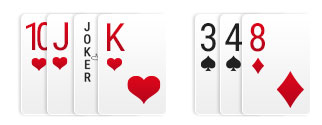
What is a Set?
Three or four cards of the same rank but different suits form a set. A set cannot have more than one card from any suit. Rummy rules allow you to use one or more jokers to replace any other card(s) in a set.
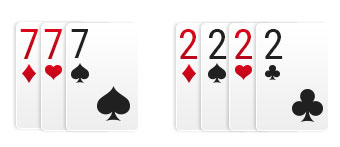 Without
a Joker
Without
a Joker
 With
a Joker
With
a Joker
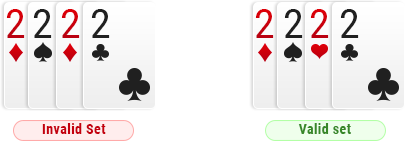 Invalid
Sets
Invalid
Sets
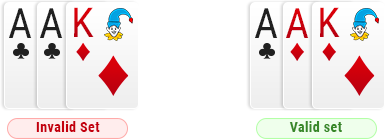 Invalid
Sets
Invalid
Sets
Importance of Jokers in Rummy
One of the most important rummy rules is how to use jokers. Jokers play a very special role in rummy and can help you win the game. There are two types of jokers used in a game of rummy: printed jokers and wild jokers.
Printed Joker
As the name suggests, a printed joker has the picture of a joker printed on it. This card can be used as a substitute for any missing card and can help you form a set or an impure sequence.
Look at the examples of an impure sequence and a set below to understand how a printed joker can be used in rummy.

Wild Joker
The wild joker is randomly picked at the beginning of the game. When the card is picked, this card along with other cards of the same rank and different suits become the wild joker of the game.
For example, if 4♦ is selected as the wild joker, 4♥, 4♣ and 4♠ will also be the wild jokers of that game.
Just like the printed joker, the wild joker can also be used as a substitute for any missing card and helps form a sequence or a set.
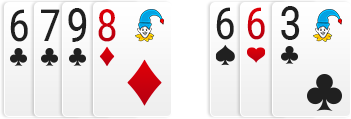
A wild joker can be used in a pure sequence too. Examples of pure sequence with a wild joker are as follows:
K♠-Q♠-J♠ (WJ): Here J♠ is the wild joker and it is used to complete the combination which ultimately forms the pure sequence.
4♥-5♥(WJ)-6♥-7♥: Here 5♥ is the wild joker and it connects 4♥, 6♥ and 7♥. The combination created is a pure sequence.
Rummy Rules for Making a Valid Declaration
Valid Declaration
To make a valid declaration, you have to arrange all 13 cards in your hand in sequences, or in sequences and sets. This should be done following all rummy game rules.
After arranging your cards, you have to finish the game by discarding the last unwanted card into the “Finish” slot and declare your hand. The player who makes a valid declaration first wins the game and gets zero points.
For a valid declaration, you need to fulfill the following three conditions:
Pure sequence: Making at least one pure sequence is mandatory to win a rummy game. A pure sequence consists of three or more consecutive cards of the same suit.
Please note that a printed joker cannot be used as a substitute for any card in a pure sequence. However, a wild joker can be used to create a pure sequence as long as it is a part of the suit. Any declaration made without a pure sequence is invalid and the player loses by a margin equal to the total of the values of all the cards in his/her hand.
Second sequence: Rummy rules make it mandatory to make at least two sequences to make a valid declaration in the game. So in addition to a pure sequence, you need to form a second sequence. It can be either a pure sequence or an impure one, depending on the cards you have.
As explained above, an impure sequence includes a joker acting as a substitute for any other card in an impure sequence. You can create more than two sequences too.
All your cards should be arranged: All the remaining cards that are not a part of the two sequences should be arranged in either sequences or sets. Forming a set is optional but all the cards must be a part of a valid combination.
As mentioned above, a set is a combination of three or four cards of the same rank but different suits. Look at an example of a valid declaration below.


Invalid Declaration
When you declare your cards without fulfilling any of the three conditions above, it becomes an invalid declaration. If you make an invalid declaration, you will lose the game instantly and your opponent will be declared the winner if it’s a 2-player table.
If there are more than two players at the table, the other players will keep playing until one of the remaining players makes a valid declaration. Take a look at the examples of some invalid declarations below.




Tips and Tricks to Win Rummy Games
Rummy is a skill game that can only be won with a lot of practice. It is important to know how to play rummy game and learn various tips and tricks to outsmart your opponents.
Take a look at 5 important tricks that will help you win online rummy games:
Prioritize creating a pure sequence: When cards are dealt, focus on creating a pure sequence first. It is impossible to win without having a pure sequence in your hand.
Discard high-value cards early on: In rummy, points have a negative value and high-value cards increase the risk of you losing by a big margin. So if you have unmatched high cards, discard them early on in the game.
Look for connecting cards: Collect connecting cards as they help you form sequences and sets. For example, you can use 7♣ with 5♣ and 6♣ (5♣-6♣-7♣) or with 8♣ and 9♣ (7♣-8♣-9♣).
Observe your opponents’ moves: One of the best ways to increase your chances of winning is to keep an eye on your opponents’ moves. Suppose your opponent picks 4♣. Make sure that you do not discard 2♣,3♣,5♣ and 6♣ or rank 4 cards from any other suits, if you have them.
Use jokers wisely: Jokers play a crucial role in a game of rummy. Use them smartly to form sets and sequences. If you have multiple jokers in your hand, do not hesitate to discard some if you are having difficulty forming a pure sequence.
How Are Points Calculated in a Rummy Game?
Common Rules for Point Calculation
- Card
- Value
 Printed Joker/Wild Joker
Printed Joker/Wild Joker
- Zero points
 Numbered Cards: 2, 3, 4, 5, 6, 7, 8, 9,
10
Numbered Cards: 2, 3, 4, 5, 6, 7, 8, 9,
10
- Worth their face value
 High-value Cards: Jack, Queen, King,
Ace
High-value Cards: Jack, Queen, King,
Ace
- 10 points each
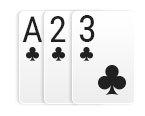 Example: A♣, 2♣, 3♣
Example: A♣, 2♣, 3♣
- 10 points, 2 points and 3 points respectively, so they add up to 15 points.
Example 1: Game played between 2 players (Player 1 and Player 2)
Suppose two players (Player 1 and Player 2) are playing a points rummy game. Player 1 makes a valid declaration and wins the game. Let us understand the rummy scoring of each player.


Example 2: Game played between 4 players (Player 1, Player 2, Players 3 and Player 4)
Suppose four players are playing a points rummy game and Player 4 is the winner of the game. Let us understand the rummy scoring for this game.




Point Calculation for Losing Players
-
In rummy, losing players get penalty points. Here’s how penalty points are calculated:
-
Wrong declaration: For an invalid declaration (a declaration made before the winner) in a rummy game, the maximum penalty points are 80, irrespective of the cards in the player’s hand. So double-check your hand before making a declaration.
-
First drop: If you quit the game before or during your very first move without picking a card, it is called a first drop. The penalty points for a first drop are 20 in a points rummy game.
-
Middle drop: If you drop out of a points rummy game any time after your first turn, you will get 40 points as a penalty. Consecutive misses: If you miss three consecutive turns, you will be automatically dropped out of the game. It will be considered a middle drop and you will get a penalty of 40 points.
-
Losing player with a valid hand: A player who declares his/her hand second and has a valid hand gets 2 penalty points. So if you make a valid declaration first and your opponent also has a valid hand, your opponent will lose by two points.
-
Leaving the table: You will get a middle drop of 40 points if you leave the table after picking a card.
Point Calculation in Cash Games on Rummy Pay
By now you might have understood how to play rummy well. However, do you know how winnings are calculated in cash rummy games ? Rummy Pay uses the following simple formulas to calculate the winning amount:
1. Points Rummy
In a cash game of points rummy, each point has a pre-decided value in rupees. The winner gets the amount lost by all the losing players at the table after the deduction of a very small Rummy Pay fee.
The formula used to calculate the winnings in a points rummy game is as follows:
Winnings = Sum of the points of all the losing players x Value of each point in rupees – Rummy Pay fee.
Example
Suppose there are four players playing a cash points rummy game at a ₹160 table. The pre-decided value of each point is ₹2. Player 1 wins the game, and the other three players lose by 20, 40 and 50 points, respectively.
In this case, the winnings will be calculated as: 2 x (20+40+50) = ₹220. This amount will be added to the winner’s account wallet after the deduction of the Rummy Pay fee.
2. Pool Rummy
The following formula is used to calculate winnings in a pool rummy game:
Winnings = (Entry fee x Number of players) – Rummy Pay fee.
Example
Suppose four players are playing a cash pool rummy game that has a fixed entry fee of ₹100. The prize pool of the game will be 100 x 4= ₹400. The winner of the game will get the following amount as the cash prize: ₹400 – Rummy Pay fee.
3. Deals Rummy
In a game of deals rummy , the winner gets chips equal to the points lost by the losing players. The formula used to calculate winnings in deals rummy is as follows:
Winnings = (Entry fee × Number of players) – Rummy Pay Fee.
Example
Imagine two players are playing a deals rummy game and the entry fee is ₹5 each. Player 2 makes a valid declaration. The prize pool of the game will be 5 x 2= ₹10. The winnings calculated will be as follows:
Winnings = ₹10 – Rummy Pay fee.
Important Terms to Know for Understanding Rummy Rules
Here are some important rummy terms you should know to understand how to play rummy game:
1. Rummy Table
In online rummy, players play the game at a virtual table. Typically two to six players can play at a rummy table.
2. Sorting
The sorting of cards is done at the beginning of the game. Simply click on the “Sort” button and your cards will be automatically arranged in combinations according to suit. Sorting is useful to identify potential combinations like pure sequences, impure sequences and sets.
3. Deal/Round
In rummy, a deal or round begins with the dealing of cards and ends when a player successfully declares his/her hand.
4. Dealing
At the beginning of a rummy game, cards are dealt to each player randomly. This process is known as dealing.
5. Drawing and Discarding
In a rummy card game, you can draw or pick cards from the closed deck (pile of cards placed face down) or the open deck (pile of cards discarded by players and placed face up).
On each turn, you have to draw a card and discard an unwanted card from your hand. These actions of picking new cards and getting rid of your unwanted cards are known as drawing and discarding respectively.
6. Melding
When cards have been dealt, players have to arrange their cards in sequences, or sequences and sets. The act of arranging cards in such valid groups is known as melding.
7. Printed and Wild Jokers
Jokers are essential to a rummy game. There are two types of jokers: printed jokers (1 per deck) and wild jokers (4 per deck). Both types of jokers can be used as substitutes for any missing cards in a set or sequence. They help to form sets and sequences.
A random card is selected as the wild joker at the beginning of the game. The cards of the same rank in all the four suits also become wild jokers.
8. Drop
You can choose to opt out of the deal/game during any time in the game. This is known as a drop. You get some penalty points for dropping out of a game/deal.
For example, in a points rummy game, you get 20 points for dropping out before your very first move in the game and 40 points for dropping out anytime after picking your first card. Dropping before you play your first move is called a first drop, and dropping in the middle of a game is called a middle drop.
9. Chips
Chips are used to play practice games on Rummy Pay. You get free chips when you register on Rummy Pay and you can reload chips when you run out of them.
When you join a practice game, a predefined number of chips will be deducted from your chip balance. When you win, the virtual chips won are credited to your account.
10. Declare
Immediately after you finish a game by discarding one of your cards to the “Finish” slot, you have to show your cards to your opponents. This is called declaring your hand.








